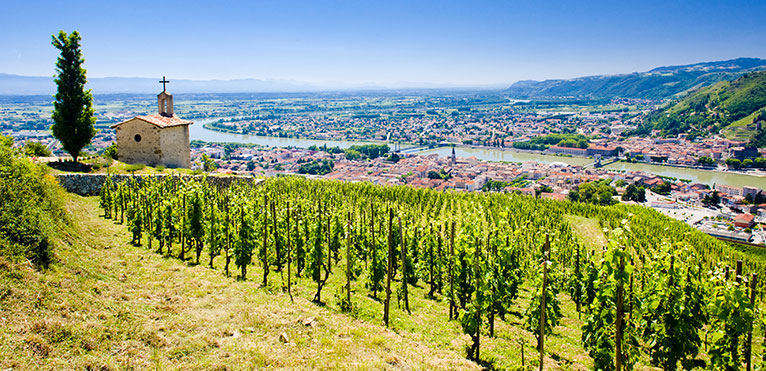
Contents
Cairanne is a wine appellation in the Rhône Valley. This appellation produces predominantly red wines (96%), but there are also some high-quality white wines. Cairanne has benefited from an Appellation d’Origine Contrôlée (AOC) since 2016.
Cairanne’s complex and rich history
The Cairanne region has been involved in winemaking since Roman times: amphorae have been found, as well as statuettes glorifying Bacchus, the god of wine. It’s easy to imagine the Romans celebrating the Bacchanalia, an annual pagan festival, with Cairanne in their cups.
From the 12th century onwards, production was continued by the Knights Templar. In 1722, the law prohibited grape harvests, and in 1766 required innkeepers to sell only Cairanne wine. This wine has the Appellation d’Origine Contrôlée Villages label, which confers excellence on it and is proof of its historical heritage.
Only seventeen Rhone Valley appellations have the “Village” designation, allowing the wine to demonstrate its uniqueness.
The Rhône region, fertile ground for Cairanne wine
Cairanne lies close to the Rasteau and Plan de Dieu appellations, in a hot, windy climate accompanied by intense summer thunderstorms. This “explosive” blend gives the wine great character and power. Covering 950 hectares, Cairanne grows on red clay-limestone and sandstone soils.
Cairanne wines, sophisticated blends for a memorable tasting experience
Red Cairanne is made from a variety of grape varieties, mainly Syrah, Grenache Noir and Mourvèdre. You can also add Cinsault or Carignan, the latter offering a pleasant acidity. White wines are made from Grenache Blanc (20%), Clairette (30%) and Roussanne (20%), although other grape varieties are also possible, such as Viognier, Picpoul, Marsanne and Bourboulenc.
Cairanne red is crimson in color, with a nose of fruit that evolves into leather and truffles. On the palate, the red is soft and smooth, giving it a well-balanced taste.
The white has a straw-coloured straw-coloured, with green highlights. The nose presents floral notes but eventually reveals fruit notes such as peach. Fresh on the palate, this white wine displays its mineral and floral complexity, always with roundness.
Cairanne wines are known as vin de garde (wines for laying down), to be kept for ten years or more.
Cairanne wines, a sure bet
Cairanne wines go perfectly with simple, family-style dishes, such as entrecote steak, herb-flavored chicken and fajitas for the red. More generally, red Cairanne goes wonderfully with game or grilled meats.
White Cairanne goes best with a warm goat’s cheese salad, or fish. Red or white, this is a gastronomic wine, always in a hedonistic spirit, a lover of good food.
The ideal tasting temperature is 15 to 17 degrees for reds, and 9 to 10 degrees for whites.
2011, a very good year for Cairanne
There are an incredible number of years to remember when tasting a Cairanne. The reds include 1945, 1946, 1947, 1961, 1978, 1985, 1988, 1989, 1990, 1998, 2000, 2001, 2005 and 2011 as the best vintages, 1947, 1985 and 2005 as exceptional vintages, 1961, 1978, 1990 and 2000 as vintages of the century, and 1989 and 1998 as vintages of the millennium.
In white, 1947, 1949, 1961, 1978, 1983, 1988, 1989, 1990, 1998 and 2005 are the best vintages, 1947, 1949, 1983, 1988 and 2005 the exceptional vintages, 1961, 1989 and 1998 the vintages of the century and 1978 the vintage of the millennium.
Two areas to remember to appreciate the greatness of Cairanne
Domaine L’Ameillaud
In the heart of La Meyeau, the domaine invites Cairanne enthusiasts to rediscover this wine through tastings and house rentals, to get the most out of the area. Around the middle of the 19th century, a group of farmers created a small estate which grew over the years to become the pleasant Domaine L’Ameillaud we know today.
The owners of the site, Nick and Sabine, have chosen to develop a small-scale production, focused on quality rather than quantity. Cairanne wines from this domaine are then even more complex and enjoyable, with spicy notes coupled with grape flavors.
It’s in this idyllic setting that wine lovers and neophytes alike can appreciate the subtlety of Cairanne.
Domaine Boisson
In the 19th century, the Boisson estate was a mixed farming operation. Alongside vines, the cultivated land produces cereals and olives, typical products of the region.
After the Second World War, René Boisson brought the estate to fruition: tractors replaced the use of horses, and the estate expanded accordingly. In 1986, the first bottle of Domaine Boisson was ready, and so began the success story of the estate.
Today, harvesting is still done by hand, with the grapes carefully and precisely sorted to ensure that only the best grapes are kept. It’s truly the ideal environment combined with the freedom of spirit of the grape-pickers that gives rise to the making of this exceptional wine, on an estate steeped in history.
Discover Cairanne’s best wineries.